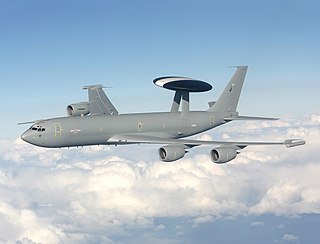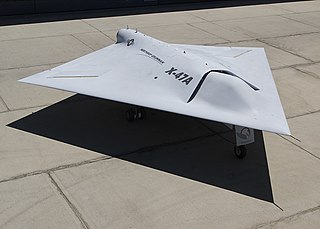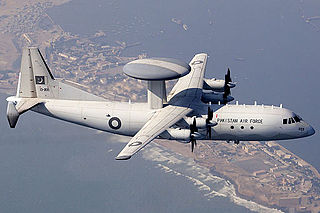
The Northrop Grumman E-2 Hawkeye is an American all-weather, carrier-capable tactical airborne early warning (AEW) aircraft. This twin-turboprop aircraft was designed and developed during the late 1950s and early 1960s by the Grumman Aircraft Company for the United States Navy as a replacement for the earlier, piston-engined E-1 Tracer, which was rapidly becoming obsolete. The aircraft's performance has been upgraded with the E-2B and E-2C versions, where most of the changes were made to the radar and radio communications due to advances in electronic integrated circuits and other electronics. The fourth major version of the Hawkeye is the E-2D, which first flew in 2007. The E-2 was the first aircraft designed specifically for AEW, as opposed to a modification of an existing airframe, such as the Boeing E-3 Sentry. Variants of the Hawkeye have been in continuous production since 1960, giving it the longest production run of any carrier-based aircraft.

The Grumman C-2 Greyhound is a twin-engine, high-wing cargo aircraft designed to carry supplies, mail, and passengers to and from aircraft carriers of the United States Navy. Its primary mission is carrier onboard delivery (COD). The aircraft provides critical logistics support to carrier strike groups. The aircraft is mainly used to transport high-priority cargo such as jet engines and special stores, mail, and passengers between carriers and shore bases.

An airborne early warning and control (AEW&C) system is an airborne radar early warning system designed to detect aircraft, ships, vehicles, missiles and other incoming projectiles at long ranges, as well as performing command and control of the battlespace in aerial engagements by informing and directing friendly fighter and attack aircraft. AEW&C units are also used to carry out aerial surveillance over ground and maritime targets, and frequently perform battle management command and control (BMC2). When used at altitude, the radar system on AEW&C aircraft allows the operators to detect, track and prioritize targets and identify friendly aircraft from hostile ones in real-time and from much farther away than ground-based radars. Like ground-based radars, AEW&C systems can be detected and targeted by opposing forces, but due to aircraft mobility and extended sensor range, they are much less vulnerable to counter-attacks than ground systems.

The Grumman E-1 Tracer was the first purpose-built airborne early warning aircraft used by the United States Navy. It was a derivative of the Grumman C-1 Trader and entered service in 1958. It was replaced by the more modern Grumman E-2 Hawkeye by the 1970s.

The Grumman C-1 Trader is a carrier onboard delivery (COD) variant of the Grumman S-2 Tracker. It was replaced by a similar version of the Northrop Grumman E-2 Hawkeye, the Grumman C-2 Greyhound.

Carrier onboard delivery (COD) is the use of aircraft to ferry personnel, mail, supplies, and high-priority cargo, such as replacement parts, from shore bases to an aircraft carrier at sea. Several types of aircraft, including helicopters, have been used by navies in the COD role. The Grumman C-2 Greyhound has been the United States Navy's primary COD aircraft since the mid-1960s.

The Northrop Grumman X-47 is a demonstration unmanned combat aerial vehicle. The X-47 began as part of DARPA's J-UCAS program, and is now part of the United States Navy's UCAS-D program to create a carrier-based unmanned aircraft. Unlike the Boeing X-45, initial Pegasus development was company-funded. The original vehicle carries the designation X-47A Pegasus, while the follow-on naval version is designated X-47B.

An active electronically scanned array (AESA) is a type of phased array antenna, which is a computer-controlled antenna array in which the beam of radio waves can be electronically steered to point in different directions without moving the antenna. In the AESA, each antenna element is connected to a small solid-state transmit/receive module (TRM) under the control of a computer, which performs the functions of a transmitter and/or receiver for the antenna. This contrasts with a passive electronically scanned array (PESA), in which all the antenna elements are connected to a single transmitter and/or receiver through phase shifters under the control of the computer. AESA's main use is in radar, and these are known as active phased array radar (APAR).
The Yakovlev Yak-44 was a proposed twin-turboprop Airborne Early Warning (AEW) aircraft, resembling the United States Navy's E-2 Hawkeye, intended for use with the Soviet Navy's Ulyanovsk class supercarriers. Along with the aircraft carrier it would have flown from, the Yak-44 was cancelled after the demise of the Soviet Union. A full-scale mockup with foldable wings was built.

The Shaanxi Y-8 or Yunshuji-8 aircraft is a medium size medium range transport aircraft produced by Shaanxi Aircraft Corporation in China, based on the Soviet Antonov An-12. It has become one of China's most popular military and civilian transport/cargo aircraft, with many variants produced and exported. Although the An-12 is no longer made in Ukraine, the Chinese Y-8 continues to be upgraded and produced. An estimated 169 Y-8 aircraft had been built by 2010.

The Northrop Grumman X-47B is a demonstration unmanned combat aerial vehicle (UCAV) designed for aircraft carrier-based operations. Developed by the American defense technology company Northrop Grumman, the X-47 project began as part of DARPA's J-UCAS program, and subsequently became part of the United States Navy's Unmanned Combat Air System Demonstration (UCAS-D) program. The X-47B is a tailless jet-powered blended-wing-body aircraft capable of semi-autonomous operation and aerial refueling.

The Xi'an Y-7 is a twin turboprop transport/passenger aircraft built in China. It is based on the Soviet-designed Antonov An-24 series.

The KJ-200 NATO reporting name: Moth or Y-8 Balance Beam system, is an airborne early warning and control (AEW&C) program developed by Shaanxi Aircraft Corporation..

The Shaanxi Y-9 is a medium military transport aircraft produced by Shaanxi Aircraft Company in China. It is a stretched and upgraded development of the Shaanxi Y-8F.
Since the 1970s, China's People's Liberation Army Navy (PLAN) has had ambitions to develop and operate aircraft carriers, and since 1985 has acquired four retired aircraft carriers for study; namely, the British-built Australian HMAS Melbourne and the ex-Soviet carriers Minsk, Kiev and Varyag. The Varyag later underwent an extensive refit to be converted into the Liaoning, China's first operational aircraft carrier, which also served as a basis for China's subsequent design iterations.

The Fairey Gannet AEW.3 is a variant of the Fairey Gannet anti-submarine warfare aircraft intended to be used in the airborne early warning (AEW) role on aircraft carriers of the Royal Navy. It was introduced to service in 1959 to replace the obsolete Douglas Skyraider, and was intended as an interim solution until the planned introduction of a new, purpose built AEW platform for use on the planned CVA-01 aircraft carriers. Neither the new aircraft carriers nor the new AEW aircraft were proceeded with, and the Gannet AEW.3 remained in service until the last aircraft carrier that could operate it was retired in 1978.

The Hawker Siddeley P.139B was a proposed airborne early warning aircraft intended to operate from aircraft carriers of the Royal Navy. The P.139B formed part of the a major equipment procurement plan for the RN in the 1960s intended to give the service a force of new, modern carriers capable of operating air groups consisting of equally modern aircraft. However, cuts in defence spending by the British government in the mid-1960s meant that these proposals never came to fruition.

The Unmanned Carrier-Launched Airborne Surveillance and Strike (UCLASS) was a United States Navy program to develop an autonomous carrier-based unmanned combat aerial vehicle providing an unmanned intelligence and strike asset to the fleet. After debate over whether the UCLASS should primarily focus on stealthy bombing or scouting, the Pentagon instead changed the program entirely into the Carrier-Based Aerial-Refueling System (CBARS) to create a UAV for aerial refueling duties to extend the range of manned fighters, which led to the Boeing MQ-25 Stingray.

Fujian, named after Fujian province, is the third aircraft carrier of the Chinese aircraft carrier programme and the first of the Type 003 class. Built by the Jiangnan Shipyard for the People's Liberation Army Navy (PLAN), Fujian was launched on June 17, 2022 and is currently fitting out as of January 2024. It is China's first CATOBAR aircraft carrier with a fully indigenous design, an integrated propulsion system and three electromagnetic catapults, unlike the ski-jump flight decks of the previous Chinese aircraft carriers.

The Boeing MQ-25 Stingray is an aerial refueling drone that resulted from the Carrier-Based Aerial-Refueling System (CBARS) program, which grew out of the earlier Unmanned Carrier-Launched Airborne Surveillance and Strike (UCLASS) program. The MQ-25 first flew on 19 September 2019.

















